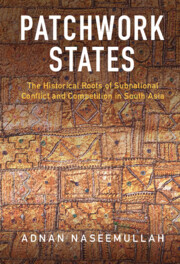Book contents
- Patchwork States
- Patchwork States
- Copyright page
- Contents
- Figures
- Tables
- Preface
- Abbreviations
- Part I Framework
- Part II Historical Roots
- Part III Contemporary Consequences
- Part IV Conclusions
- 9 Researching the Legacies of Colonial Rule
- 10 The Patchwork State in Comparative Perspective
- Book part
- References
- Index
10 - The Patchwork State in Comparative Perspective
from Part IV - Conclusions
Published online by Cambridge University Press: 09 June 2022
- Patchwork States
- Patchwork States
- Copyright page
- Contents
- Figures
- Tables
- Preface
- Abbreviations
- Part I Framework
- Part II Historical Roots
- Part III Contemporary Consequences
- Part IV Conclusions
- 9 Researching the Legacies of Colonial Rule
- 10 The Patchwork State in Comparative Perspective
- Book part
- References
- Index
Summary
This final chapter explores the patchwork state in comparative perspective. It places the uneven state-building trajectories of India, Pakistan, and Bangladesh in the context of broader South Asia. It then contrasts South Asian patchwork states with dynamics in East and Southeast Asian cases, which had internal differentiation in colonial governance, but also Japanese conquest and postwar revolutionary and counterrevolutionary mobilization. The chapter concludes with the application of fear, greed and frugality in the creation of the British and American Empires, and their consequences in state strength and weakness.
Keywords
- Type
- Chapter
- Information
- Patchwork StatesThe Historical Roots of Subnational Conflict and Competition in South Asia, pp. 250 - 265Publisher: Cambridge University PressPrint publication year: 2022

